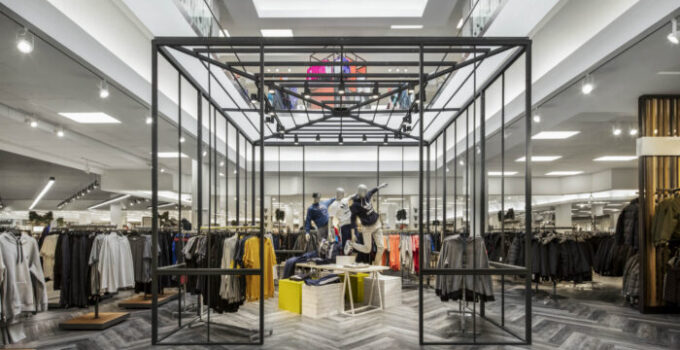In the extremely competitive world of retail, the physical store’s design and layout are critical to attracting customers, improving their shopping experience, and ultimately increasing corporate profitability. Creating a timeless and appealing shop design is a deliberate activity that needs a thorough grasp of your target audience, the capacity to react to changing market circumstances, and a dedication to giving consumers an engaging and memorable experience. In this article, we will look at six crucial principles and trends for establishing a timeless store design that will last.
1. Customer-Centric Layout
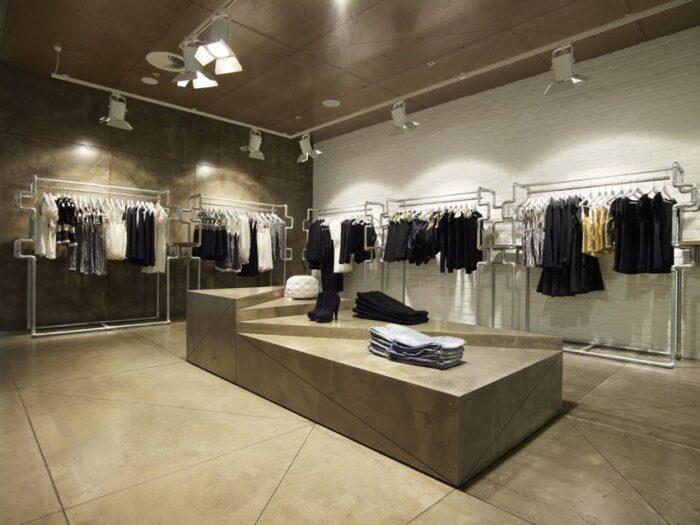
The layout of your business is the basis of your retail space, and it has a big influence on the consumer experience. Consider the following components while creating a customer-centric layout:
- Traffic Flow: The flow of traffic within your store should be intuitive, allowing customers to navigate seamlessly. Consider the natural path that consumers would follow, and make sure that high-traffic areas are clear of obstacles. Use signs and floor markings to help clients locate what they’re looking for by guiding them through different regions.
- Product Placement: Strategically arranging your merchandise may significantly increase sales. High-margin or popular items should be prominently displayed at eye level to catch customers’ attention. Create focal points with eye-catching displays to draw shoppers into the heart of your store.
- Comfort and Accessibility: A comfortable shopping environment is essential. Make sure there is enough space between the aisles to avoid congestion. Additionally, make your shop accessible to all consumers, especially those with mobility issues, by following ADA (Americans with Disabilities Act) rules. This not only serves a larger audience but also indicates your dedication to inclusion.
You can build a shopping area that is efficient, easy to traverse, and personalized to your customer’s requirements by analyzing and fine-tuning your store layout regularly based on consumer feedback and data analytics.
2. Mix of Online and Offline

Source: pinterest.com
In the current era of digitalization, the distinction between online and in-store shopping is progressively fading. To stay competitive, retailers need to create a seamless bridge between these two realms. Here are various methods for achieving this integration:
- Interactive Screens: Install interactive panels or kiosks in your store so that clients may browse your internet catalog. These panels may be used to verify product availability, read customer feedback, and even place orders for things that may not be in stock. Interactive displays bridge the gap between in-store and online buying, offering customers a simple and information-rich experience.
- QR Codes: Place QR codes next to products, linking to additional information, reviews, or the option to purchase online. This enables tech-savvy customers to interact with your business both in-store and via mobile devices.
- Mobile Apps: Consider creating a mobile app for your store that provides special in-store discounts, loyalty benefits, and an easy buying experience. Ensure that the app seamlessly transitions between online and in-store shopping. This provides customers with the flexibility to start shopping online and complete their purchases in-store or vice versa.
By incorporating technology that facilitates a smooth transition between the physical and digital retail worlds, you can cater to the preferences of modern shoppers and enhance their overall experience.
3. Sustainable Design
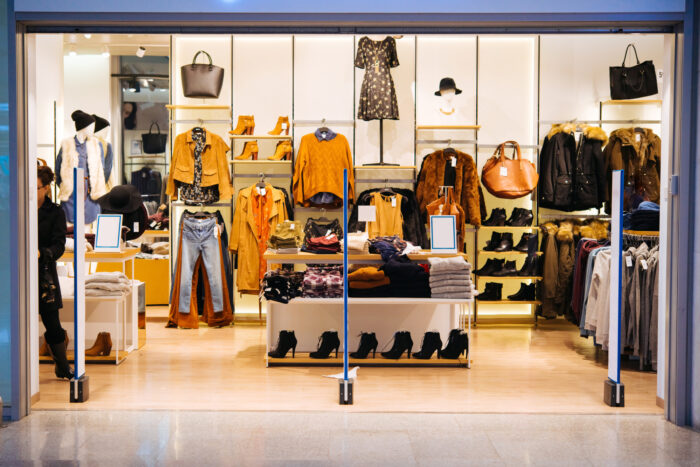
Source: azbigmedia.com
As sustainability becomes an increasingly significant concern for both businesses and consumers, integrating eco-friendly practices into your store design can have a positive impact on your brand image and long-term operational costs. Here’s how you can embrace sustainable design:
- Eco-Friendly Materials: Choose construction materials, fixtures, and displays made from recycled or sustainable materials. Not only do these choices reduce your environmental footprint, but they also resonate with environmentally conscious customers.
- Energy Efficiency: Implement energy-efficient lighting, such as LED fixtures, to reduce your store’s energy consumption. Investing in sustainable lighting not only lowers operational costs but also contributes to a more eco-friendly image.
- Waste Reduction: Minimize packaging waste by opting for eco-friendly packaging materials, and encourage customers to bring their reusable shopping bags. Additionally, provide recycling bins within your store to promote responsible waste disposal.
- Green Initiatives: Consider larger sustainability efforts, such as energy-efficient HVAC systems and the use of renewable energy sources like solar panels. Communicate these green initiatives to your customers, as it can be a powerful selling point that resonates with the environmentally conscious segment of your audience.
By integrating sustainability into your store’s design, you not only reduce your environmental impact but also align your brand with the values of a growing number of conscious consumers.
4. Flexible and Modular Fixtures
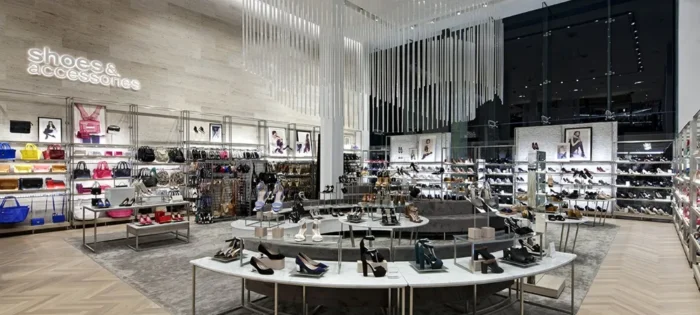
Flexible in-store design is essential for adapting to changing seasons, promotions, and evolving customer preferences. To create a flexible retail space, consider the following:
- Modular Shelving and Displays: Opt for fixtures and shelving units that can be easily reconfigured. These modular elements allow you to adapt your store’s layout and product placement to accommodate different seasons and promotions. This adaptability keeps your store looking fresh and exciting, encouraging repeat visits.
- Removable Graphics and Signage: Use removable graphics and signage that can be changed without damaging your store’s interior. This allows you to update your store’s look and messaging quickly, whether it’s for a holiday, a special promotion, or a change in product focus.
- Seasonal Rotation: Plan for seasonal rotations in your store’s layout and product displays. This approach keeps your store dynamic and interesting, providing your customers with a reason to return and discover new offerings.
By implementing flexible and modular design elements, you can respond to changing market dynamics and keep your retail space engaging and relevant throughout the year.
5. Technology Integration
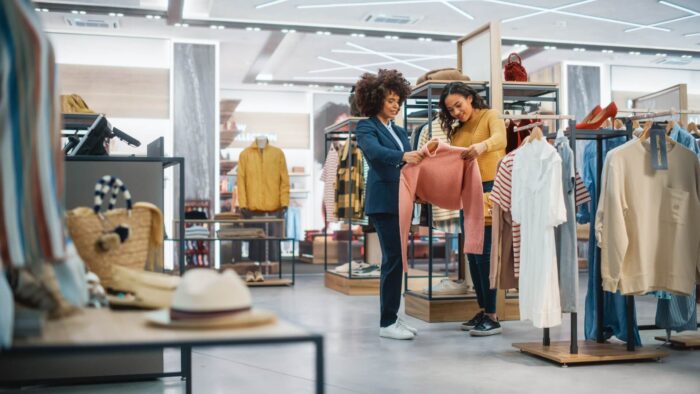
Incorporating technology into your store design can greatly enhance the shopping experience and set your store apart from the competition. Here are some ways to effectively integrate technology into your retail space:
- Digital Signage: Use digital displays to showcase dynamic content, including promotions, product videos, and customer reviews. Digital signage is eye-catching and can be easily updated to reflect changes in your inventory or marketing campaigns.
- Virtual Try-On Systems: If applicable to your products, consider implementing virtual try-on systems or augmented reality (AR) experiences. These systems allow customers to “try before they buy,” providing them with a unique and interactive shopping experience.
- Personalized Recommendations: Use data analytics and customer behavior to offer personalized product recommendations. Tailor product suggestions based on a customer’s purchase history, browsing habits, or demographics. Personalization enhances the customer experience by making shopping more relevant and engaging.
By incorporating technology, you can create a store that not only caters to the preferences of tech-savvy consumers but also provides an interactive and informative shopping environment that sets your brand apart.
In the pursuit of creating a timeless and attractive retail store design, it is paramount to emphasize the significance of consulting experienced professionals in the field, particularly when you are seeking retail design specialists in Zurich. These experts bring a wealth of knowledge and benefits to the table that can be instrumental in achieving your design goals.
6. Branding and Storytelling
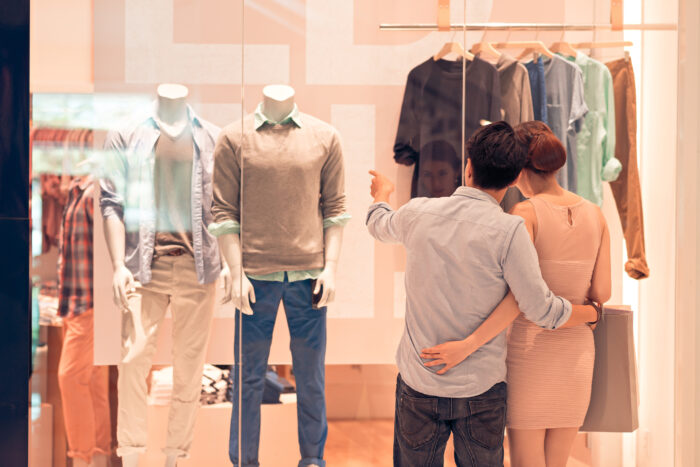
Man showing clothes in the shop window to his girlfriend, rear view
Your shop’s design should reflect your brand’s identity and convey a compelling tale. Here’s how you do it:
- Consistent Visual Elements: Your brand’s identity should reflect consistency in aspects like color schemes, logos, and typography.
- Consistency in these elements creates a cohesive and recognizable brand image.
- Visual Merchandising: Use visual merchandising techniques to create appealing displays that resonate with your brand’s image and convey the story of your products. Thoughtful merchandising can
Remember that the success of your shop design is dependent on a thorough understanding of your target demographic, regular upgrades to stay current, and a dedication to providing an excellent customer experience. You can build a retail location that draws customers, keeps them interested, and endures the test of time by adopting these techniques and trends.
Table of Content

